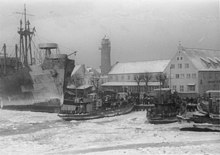
Karl Dönitz was a German admiral who briefly succeeded Adolf Hitler as head of state in May 1945, holding the position until the dissolution of the Flensburg Government following Germany's unconditional surrender to the Allies days later. As Supreme Commander of the Navy beginning in 1943, he played a major role in the naval history of World War II.
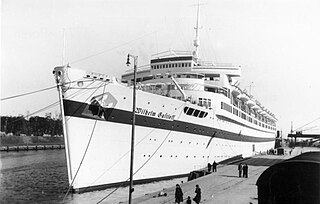
MV Wilhelm Gustloff was a German military transport ship which was sunk on 30 January 1945 by Soviet submarine S-13 in the Baltic Sea while evacuating civilians and military personnel from East Prussia and the German-occupied Baltic states, and German military personnel from Gotenhafen (Gdynia) as the Red Army advanced. By one estimate, 9,400 people died, making it the largest loss of life in a single ship sinking in history.

The Kriegsmarine was the navy of Nazi Germany from 1935 to 1945. It superseded the Imperial German Navy of the German Empire (1871–1918) and the inter-war Reichsmarine (1919–1935) of the Weimar Republic. The Kriegsmarine was one of three official branches, along with the Heer and the Luftwaffe, of the Wehrmacht, the German armed forces from 1935 to 1945.

The Laconia incident was a series of events surrounding the sinking of a British passenger ship in the Atlantic Ocean on 12 September 1942, during World War II, and a subsequent aerial attack on German and Italian submarines involved in rescue attempts. RMS Laconia, carrying 2,732 crew, passengers, soldiers, and prisoners of war, was torpedoed and sunk by U-156, a German U-boat, off the West African coast. Operating partly under the dictates of the old prize rules, the U-boat's commander, Korvettenkapitän Werner Hartenstein, immediately commenced rescue operations. U-156 broadcast her position on open radio channels to all Allied powers nearby, and was joined by the crews of several other U-boats in the vicinity.
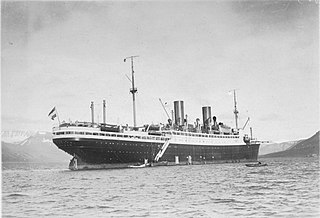
SS General von Steuben was a German passenger liner and later an armed transport ship of the German Navy that was sunk in the Baltic Sea during World War II. She was launched in 1923 as München, renamed General von Steuben in 1930, and renamed Steuben in 1938.

The Dunkirk evacuation, codenamed Operation Dynamo and also known as the Miracle of Dunkirk, or just Dunkirk, was the evacuation of more than 338,000 Allied soldiers during the Second World War from the beaches and harbour of Dunkirk, in the north of France, between 26 May and 4 June 1940. The operation commenced after large numbers of Belgian, British, and French troops were cut off and surrounded by German troops during the six-week Battle of France.

Deutschland was the lead ship of her class of heavy cruisers which served with the Kriegsmarine of Nazi Germany during World War II. Ordered by the Weimar government for the Reichsmarine, she was laid down at the Deutsche Werke shipyard in Kiel in February 1929 and completed by April 1933. Originally classified as an armored ship by the Reichsmarine, in February 1940 the Germans reclassified the remaining two ships of this class as heavy cruisers. In 1940, she was renamed Lützow, after the unfinished Admiral Hipper-class heavy cruiser Lützow was sold to the Soviet Union the previous year.
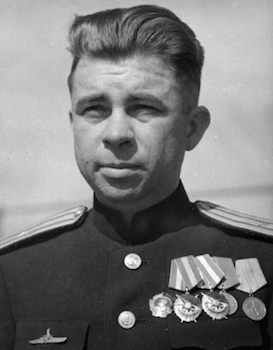
Alexander Ivanovich Marinesko was a Soviet career naval officer. During the last year of World War II, he became known as the captain of the submarine S-13, which sank the German military transport ship Wilhelm Gustloff in the Baltic Sea in January 1945. Passengers included civilians and women and children being evacuated from East Prussia, in addition to military and related personnel. More than 9300 of the more than 10,000 passengers and crew died.

Goya was a Norwegian motor freighter used as a troop transport by Nazi Germany and sunk with a massive loss of life near the end of World War II.

The evacuation of East Prussia was the movement of German civilian population and military personnel from East Prussia between 20 January and March 1945, that was initially organized and carried out by state authorities but quickly turned into a chaotic flight from the Red Army.

Admiral Hipper was the lead ship of the Admiral Hipper class of heavy cruisers which served with Nazi Germany's Kriegsmarine during World War II. The ship was laid down at the Blohm & Voss shipyard in Hamburg in July 1935 and launched February 1937; Admiral Hipper entered service shortly before the outbreak of war, in April 1939. The ship was named after Admiral Franz von Hipper, commander of the German battlecruiser squadron during the Battle of Jutland in 1916 and later commander-in-chief of the German High Seas Fleet. She was armed with a main battery of eight 20.3 cm (8 in) guns and, although nominally under the 10,000-long-ton (10,160 t) limit set by the Anglo-German Naval Agreement, actually displaced over 16,000 long tons (16,260 t).

The Baltic Sea campaigns were conducted by Axis and Allied naval forces in the Baltic Sea, the Gulf of Bothnia, the Gulf of Finland and the connected lakes Ladoga and Onega on the Eastern Front of World War II. After early fighting between Polish and German forces, the main combatants were the Kriegsmarine and the Soviet Navy, with Finland supporting the Germans until 1944 and the Soviets thereafter. The Swedish Navy and merchant fleet played important roles, and the British Royal Navy planned Operation Catherine for control of the Baltic Sea and its exit choke point into the North Sea.

The Soviet hospital ship Armenia was a transport ship operated by the Soviet Union during World War II to carry both wounded soldiers and military cargo. It had originally been built as a passenger ship for operations on the Black Sea.
The Black Sea Campaigns were the operations of the Axis and Soviet naval forces in the Black Sea and its coastal regions during World War II between 1941 and 1944, including in support of the land forces.
German submarine U-3505 was a Type XXI submarine of Nazi Germany's Kriegsmarine during World War II. The U-boat was laid down on 9 July 1944 at the Schichau-Werke yard at Danzig, launched on 25 August 1944, and commissioned on 7 October 1944 under the command of Oberleutnant zur See Horst Willner.

The German torpedo boat T36 was the last of 15 Type 39 torpedo boats built for the Kriegsmarine during World War II. Completed in late 1944, T36 was assigned to convoy escort duties and supporting German forces in the Baltic. At the end of January 1945, she rescued survivors from the torpedoed ocean liner MV Wilhelm Gustloff. The boat screened German warships as they bombarded advancing Soviet troops and escorted convoys over the next several months. In May, T36 began to ferry refugees; she struck a mine on 4 May and was sunk by Soviet aircraft the following day.

Wilhelm Zahn was a German Kriegsmarine officer during the Second World War. He was U-boat First Watch Officer, then became U-boat commander and was finally promoted to Korvettenkapitän on 1 April 1943. As commander of U-56 he was able to avoid detection by the destroyers surrounding HMS Nelson and came in close proximity to the British flagship, launching three torpedoes against her whilst she was carrying Winston Churchill and the high military command of the British Navy. Following that incident he became widely known as the "Man who almost killed Churchill" amongst the U-boat submariner corps. He was one of the commanding officers during the sinking of MV Wilhelm Gustloff which has been described as "Adolf Hitler'sTitanic".

Darkness Fell on Gotenhafen is a 1960 German drama film directed by Frank Wisbar. It dramatizes the sinking of MV Wilhelm Gustloff, which was sunk while carrying German servicemen and around 6,000 civilian evacuees. Heinz Schön presents the combined death toll as 9,343.
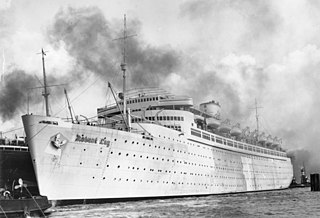
The Robert Ley was a cruise ship of the Nazi Party leisure organization Kraft durch Freude. It was considered the flagship of the KDF fleet.

The Soviet naval Baltic Sea campaign in 1945 was launched by the Soviet Navy to harass enemy shipping and naval military assets of Nazi Germany on the Eastern Front during World War II. Both submarines and surface units of the Soviet Navy were employed. The campaign scored successes during Operation Hannibal.

